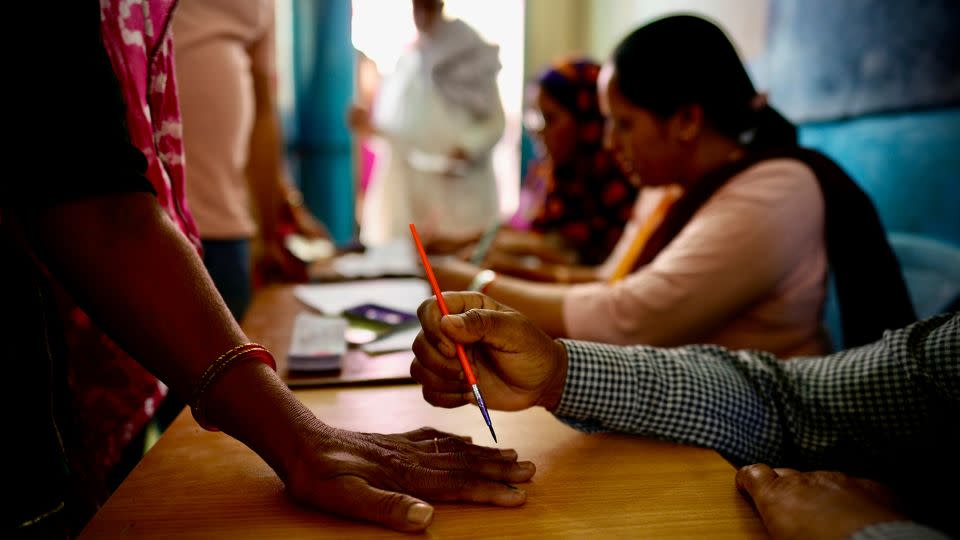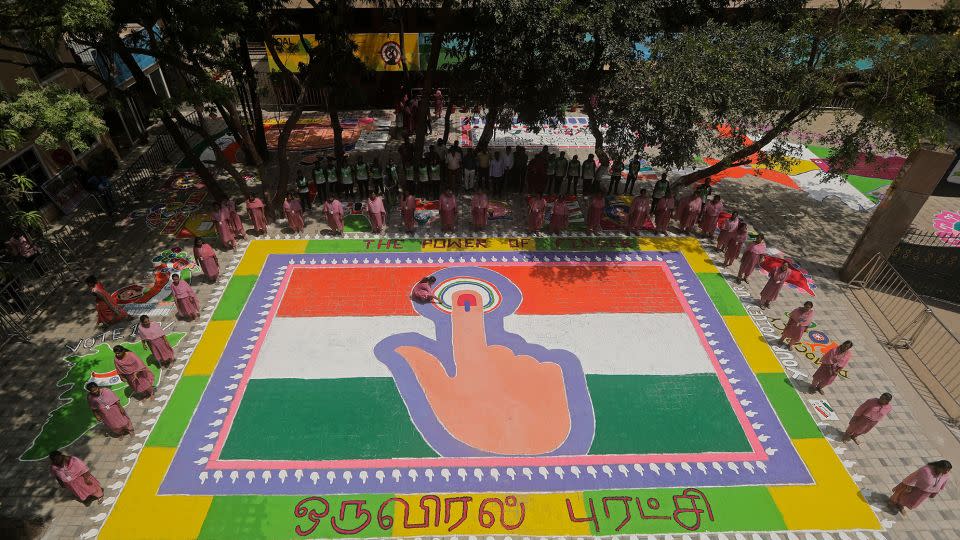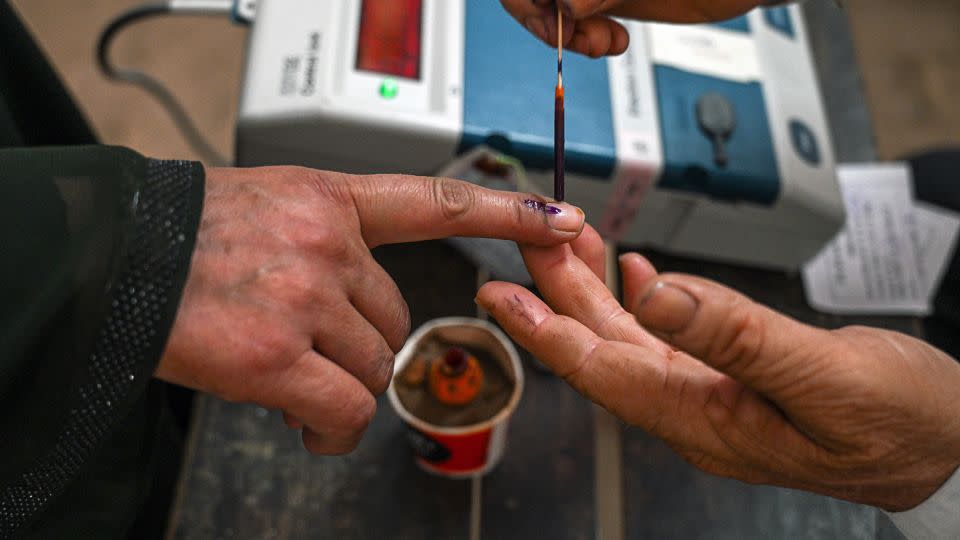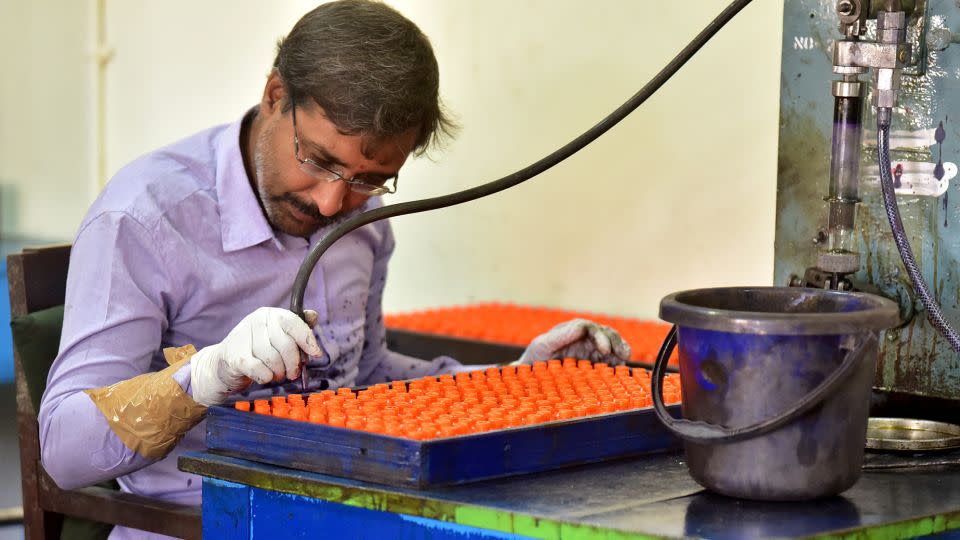‘Bound to secrecy’: The indelible ink behind the world’s biggest election
- Oops!Something went wrong.Please try again later.
India’s massive, twice-a-decade exercise in democracy is once again leaving its mark on the country’s people, in the form of purple-streaked index fingers.
The Election Commission uses indelible ink, or “voter ink”, to prevent fraud or duplicate votes. Once a voter arrives at the booth to cast their ballot and has their ID verified, the ink is painted across the top of their left index finger, leaving a stain that can take up to two weeks to wash off.
It may be rudimentary, but the method has been so effective that it’s been in place for more than seven decades.
“Right from the prime minister to the most common person, everybody flashes their (marked) finger,” said K Mohammed Irfan, managing director of Mysore Varnish and Paints Limited (MVPL), the state-owned company that exclusively makes and distributes the liquid to polling booths across the nation.
“From celebrities to film stars… (it has become) a mark of democracy that I think is synonymous with elections,” he told CNN in a video interview.


More than 960 million people are eligible to vote in India’s election, the world’s biggest. And workers at the company’s factory in Mysuru, a city in southwestern Karnataka state, have spent months preparing nearly 2.7 million ink vials, its largest order to date.
The orange containers were filled and carefully packed for distribution ahead of this year’s elections, which are underway and end June 1. Each vial contains enough liquid to mark approximately 700 voters.
The key to the ink’s literal staying power? A tightly guarded formula which has remained unchanged since 1951. “Indelible ink serves no other purpose,” said Irfan. “We only manufacture the required quantity.”
While Irfan says the company is “bound to secrecy” when it comes to the ink’s exact composition, it does contain the chemical compound silver nitrate, which causes a purplish stain when it comes into contact with skin and is exposed to sunlight.

One dab at a time
When newly independent India held its first-ever general elections in 1951 and 1952, organizers turned to the idea of using indelible ink to mark voters, in efforts to ensure a fair ballot.
“In a country where there was no systematic registration of births, or identity documents, and with millions of people on the move as refugees, the question of how to prevent impersonation and double voting was a source of great concern,” said Ornit Shani, author of “How India Became Democratic: Citizenship and the Making of the Universal Franchise.” Some officials thought the method would take too much time and complicate the voting process, according to Shani, but public opinion eventually won out.
“Combined with the practice that all voters, irrespective of their caste, class and religions would stand in the same line, (having to wait) for their turn to have their finger marked (before they) cast their vote, further contributed to making concrete and visible the core value of the equality of the vote,” Shani said in an email to CNN. “One man, one woman, one vote.”

Lasting appeal
MVPL was founded as a paint supplier in 1937 by the then maharaja or ruler of Mysore, Krishna Raja Wadiyar IV, and retains that side of its business.
According to Irfan, when the company isn’t producing ink, it’s supplying, among other products, paint for the public transport sector. The ink’s appeal has spilled beyond India’s borders too. The company now supplies indelible ink to more than 35 countries, including to Ghana beginning in the late 1970s. However, Ghana’s election commission recently announced it would phase out the use of indelible ink, opting for biometric verification methods instead.
But the use of the ink in India doesn’t appear to be going away any time soon. For Mukulika Banerjee, an associate professor of anthropology at the London School of Economics, the practice of marking a body may not translate well in other cultures, but it works in India due to common cultural practices.

“People routinely have their hands decorated with henna, or women have their feet decorated with different colors,” said Banerjee in a phone interview. “I would argue that the marking of the finger (semi-permanently) kind of fits into it in a way that it might not fit in other contexts.”
She also pointed to an unintentional effect of marking voters with ink: creating an environment of peer pressure.
Banerjee was able to find instances of this during her research on democracy and elections in West Bengal.
“First thing on polling day people do is check out each other’s fingers,” she said. “And if your left index finger is not carrying the indelible mark, they’ll look at you and the first thing they’ll say is ‘Why haven’t you voted?’
“You can make excuses, but by the fifth time in the day, if somebody asks you and it gets so annoying, it’s actually easier to go and vote than to not vote.”
The peer pressure extends to movie stars and athletes, who are likely to post their ink-stained fingers to their millions of fans on social media.
“These guys have begun to hold up (their fingers) and take selfies of having voted and say ‘I’ve voted, have you?’ because they feel they have a civic duty to encourage others to vote as well,” she added. “So it becomes aspirational; then you want to be like your hero and you want to be able to do the same thing.”
For more CNN news and newsletters create an account at CNN.com

